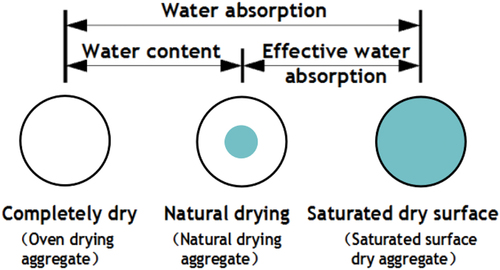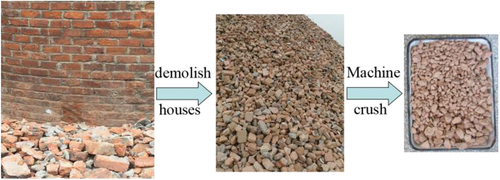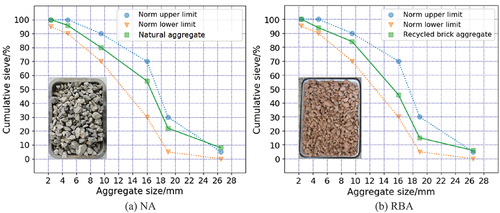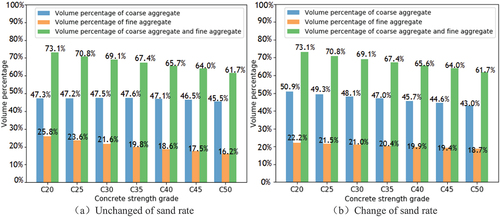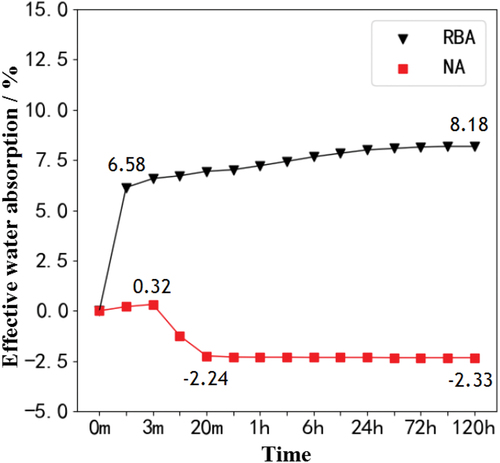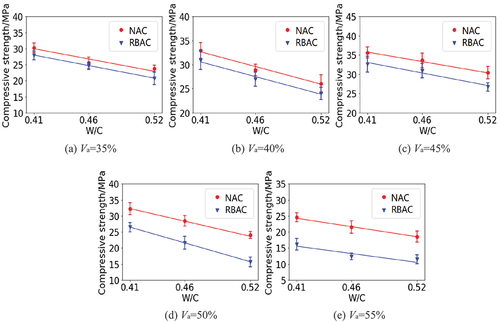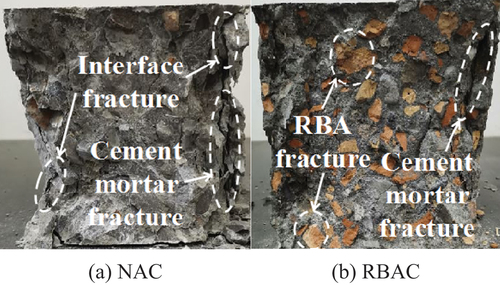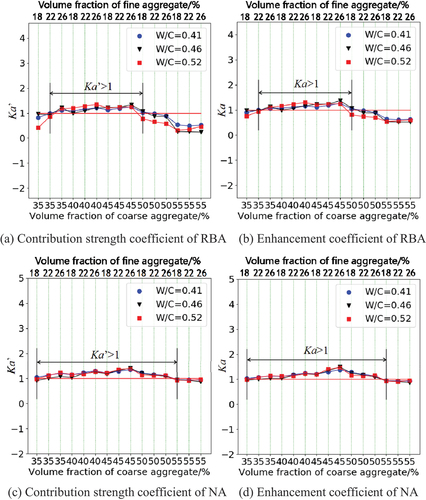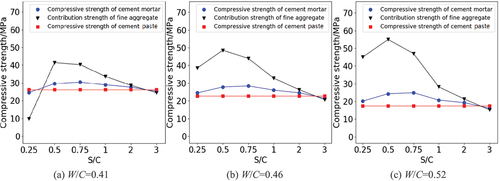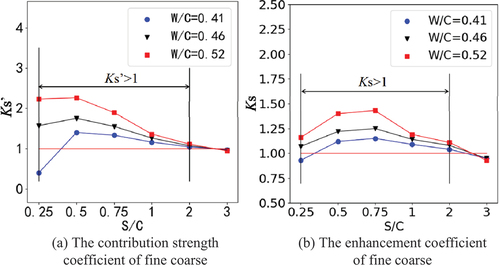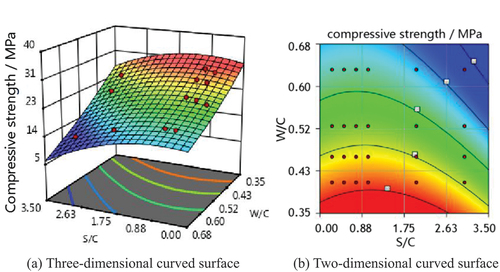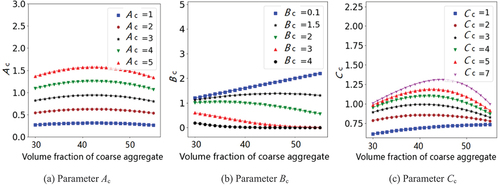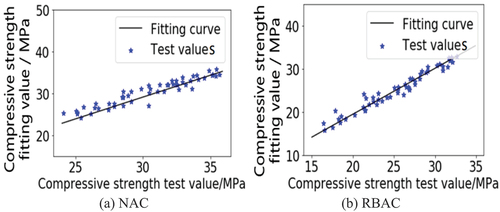 ?Mathematical formulae have been encoded as MathML and are displayed in this HTML version using MathJax in order to improve their display. Uncheck the box to turn MathJax off. This feature requires Javascript. Click on a formula to zoom.
?Mathematical formulae have been encoded as MathML and are displayed in this HTML version using MathJax in order to improve their display. Uncheck the box to turn MathJax off. This feature requires Javascript. Click on a formula to zoom.ABSTRACT
In order to study the influence of physical properties and volume content of coarse aggregate on concrete strength, the effective water absorption, apparent density and crushing index of different types of coarse aggregate were tested; the contribution strength coefficient and reinforcement coefficient of coarse and fine aggregate were proposed according to the mechanics of composite materials, the optimal range of the volume content of coarse and fine aggregate was determined, the calculation equation of concrete compressive strength based on the properties of coarse aggregate and the volume content of coarse and fine aggregate was established. The results show that: the effective water absorption of recycled brick aggregate (RBA) is 8.18% and that of natural aggregate (NA) is 0.32%; the apparent density of NA is 2713 kg/m3 and that of RBA is 2100 kg/m3; the crushing index of NA is 18.07% and that of RBA is 30.59%; furthermore, the crushing value of RBA is close to that of cement mortar with water cement ratio of 0.46; NA has a greater range of strengthening the compressive strength of concrete than RBA; when sand cement ratio is between 0.3 and 2.5, both Ks’ and Ks are greater than 1; when sand cement ratio is about 0.5, Ks’ reach the maximum value; when sand cement ratio is about 0.75, Ks reach the maximum value; the calculation equation of concrete compressive strength established in this paper has a good prediction effect, which provides a new idea for the calculation method of concrete compressive strength.
HIGHLIGHTS
The effective water absorption, apparent density and crushing index of different types of coarse aggregate were tested.
The contribution strength coefficient and reinforcement coefficient of coarse and fine aggregate were proposed.
The optimal range of the volume content of coarse and fine aggregate was determined.
The calculation equation of concrete compressive strength based on the properties of coarse aggregate and the volume content of coarse and fine aggregate was established.
1. Introduction
Concrete is a three-phase composite material composed of cement mortar, coarse aggregate and interface transition zone. Its strength is affected by factors such as water cement ratio, the strength of interface transition zone and coarse aggregate. The research results of literatures (Struble, Skalny, and Mindess Citation1980; Trende and Büyükztürk Citation1998) showed that the strength difference between cement mortar and coarse aggregate had a great impact on the development law of concrete strength and the later hardening strength. Only when the rigidity and strength of cement mortar and coarse aggregate match each other, the strength of coarse aggregate can be better used to improve the flexural and compressive strength of concrete. Özturan et al. (Beshr, Almusallam, and Maslehuddin Citation2003; Özturan and Çeçen Citation1997). also considered that the strength of concrete was affected by the strength of coarse aggregate. Myong et al (Myong Lee, Buyukozturk, and Oumera Citation1992). pointed out that when concrete was subjected to external forces, there were usually two kinds of crack propagation paths: first, when the strength of coarse aggregate is greater than or equal to the strength of cement mortar, the crack develops along the interface between cement mortar and coarse aggregate; second, when the strength of coarse aggregate is less than that of cement mortar, the crack passes through the coarse aggregate. The crack path around the coarse aggregate is longer than that through the coarse aggregate. The longer the crack path, the greater the energy consumption, so the longer the crack path, the greater the strength of concrete.
The compressive strength of concrete is the basic mechanical index to determine the grade of concrete, the calculation of concrete compressive strength is the basis of concrete mix design. In the study by Younis and Pilakoutas (Citation2013), considering the specific gravity and water absorption of recycled aggregate (RA), a multivariable model was established to predict the compressive strength of RA concrete (RAC). Zhang, Wang, and Song (Citation2018). presented a model for calculating the compressive strength of RAC, in which fine/coarse aggregate ratio and water cement ratio were considered. In addition, Chen et al. (Citation2019). proposed a compressive strength model of RAC with the replacement rate of recycled brick aggregate (RBA) and curing ages of concrete specimen as the independent parameters. Basaran et al. (Citation2022). used regression analysis to establish the relationship between concrete strength and experimental parameters, which include powder, fine aggregate and coarse aggregate of marble. Zeybek et al (Çelik et al. Citation2022; Qaidi et al. Citation2022; Zeybek et al. Citation2022). established equation among concrete compressive strength, splitting tensile strength, flexural strength and waste glass replacement rate. The experimental results show that the prediction accuracy of the equation established is high. Ziembicka (Citation1977) pointed out that the strength of concrete mainly depended on water cement ratio and compactness. She (Citation2007) insisted that there was a linear relationship between concrete strength and water cement ratio. It is well known that RA or lightweight aggregate (LA) has high water absorption and porosity, high crushing value. Furthermore, there is a large amount of aggregate crushing in the failure of RAC or lightweight aggregate concrete (LAC), which is very different from natural aggregate concrete (NAC). Therefore, some scholars have revised Bolomey equation according to the characteristics of RA or LA. According to Rajamane and Ambily (Citation2012), they revised Bolomey equation, in which water cement ratio, the compressive strength and volume fraction of LA were considered. In another study by Kargari et al. (Kargari, Eskandari-Naddaf, and Kazemi Citation2018), a calculation model of compressive strength of concrete by modifying Bolomey equation was proposed considering sand cement ratio and cement strength grade. Dan et al (Dan et al. Citation2021). established a modified empirical equation based on a strength-based mix design method, considering cement content and replacement rate of RA as factors. Kong (Citation2003) found that there was a good linear relationship between the coefficients A and B in Bolomey equation of various coarse aggregate concrete and the crushing index of coarse aggregate. He also modified Bolomey equation based on the crushing index of coarse aggregate. Zhang et al. (Citation2012) revised Bolomey equation using the water absorption and apparent density of RA. Guo et al (Citation2018). also revised Bolomey equation in consideration of the influence of RA properties and replacement rate. Li (Citation2005). found that there was a parabolic relationship between the strength of RAC and the crushing index of RA. They used the crushing index of RA as a parameter to regress the calculation equation of the strength of RAC.
Although the properties of coarse aggregate were considered in the above study, it is mainly the modification of Bolomey equation. In addition, the factors affecting the compressive strength of concrete include not only the properties of coarse aggregate and water cement ratio, but also the volume content of aggregate (Ying and Chen Citation2011). According to the literature (Han, Zhang, and Wang Citation2013), the optimal volume fraction of coarse aggregate in concrete is about 40% ~ 47%, the optimal volume fraction of coarse and fine aggregate is about 60% ~ 70%. Nikbin et al (Citation2014a) pointed out that with the increase of coarse aggregate total volume from 30% to 60%, the compressive strength of concrete initially decreases up to aggregate volume of 40% and then increases, while tensile strength of concrete initially undergoes negligible decrease up to aggregate volume of 40% and then increases. With a constant of water cement ratio, the elastic modulus of concrete increases with the increase of the volume fraction of coarse aggregate, while the axial compressive strength of concrete decreases first and then increases. Sadrmomtazi, Lotfi-Omran, and Nikbin (Citation2020) found that when the volume fraction of coarse aggregate increases from 40% to 80%, the fracture toughness and fracture energy of high-strength concrete first increase and then decrease; when the volume fraction of coarse aggregate is 60%, the fracture toughness and fracture energy reach the maximum values. Nikbin and Beygi et al (Citation2014b). studied the effect of coarse aggregate content from 30% to 60% on the fracture parameters of self-compacting concrete. The research results showed that the fracture toughness of concrete with a volume content of 60% coarse aggregate is 38% higher than that of concrete with a volume content of 30% coarse aggregate; the brittleness of concrete with a volume content of 60% coarse aggregate is about 200% higher than that of concrete with a volume content of 30% coarse aggregate. Han, Zhang, and Gao (Citation2013). found that the flexural strength and tensile strength of concrete increased with the volume fraction of coarse and fine aggregate increased from 50% to 70%. Moini et al. (Citation2015). concluded that the performance of concrete is influenced by the properties, proportion and grading of aggregates, and the optimal volume of coarse and fine aggregates is 60% to 75%. Zhang et al. (Citation2001) found that the coarse and fine aggregates had a certain inhibiting effect on the crack propagation of concrete. They believed that: the strength of concrete increased with the increase of the volume fraction of coarse and fine aggregate; when the volume fraction of coarse and fine aggregate was 60%, the strength of concrete reaches the maximum; the strength of concrete decreased when the volume content of coarse and fine aggregate less than or greater than 60%.
The volume content of coarse and fine aggregates in the above study was considered, but the volume content of RBA and fine aggregates was not distinguished. In addition, there are few studies on the calculation method of concrete compressive strength considering the volume content of coarse and fine aggregates. In this paper, the physical properties of coarse aggregate were studied. Coarse aggregate was used as the reinforcing particle of concrete, fine aggregate was used as the reinforcing particle of cement mortar. According to the composite material mechanics, the reinforcement coefficient of coarse aggregate and fine aggregate was defined, the optimal volume content of coarse and fine aggregate was determined, the calculation method of concrete compressive strength considering the properties of coarse aggregate and the volume content of coarse and fine aggregate was established. The research results provide a new idea for the calculation method of concrete compressive strength.
2. Experimental study on the influence of the properties and volume content of coarse aggregate on concrete compressive strength
2.1. Test details
The test includes three parts: in the first part, the physical properties of coarse aggregate are taken as the research object, the effective water absorption, apparent density and crushing index of coarse aggregate are taken as variables; in the second part, the compressive strength of cement mortar is taken as the research object, the water cement ratio and sand cement ratio of cement mortar are taken as variables; in the third part, the compressive strength of concrete is taken as the research object, the water cement ratio and volume content of coarse and fine aggregate are taken as variables.
2.1.1. Test on effective water absorption, apparent density and crushing index of coarse aggregate
The relationship between water content and water absorption of coarse aggregate is shown in . It can be found that: water content is between complete drying and natural drying; effective water absorption is between natural drying and saturated dry surface; water absorption is between complete drying and saturated dry surface. The water absorption of RBA is much higher than that of the NA, so RBA needs to be soaked before mixing. In addition, the water absorption rate of coarse aggregate in natural dry state is often used in projects, so the water content and effective water absorption rate of coarse aggregate are tested. The water absorption rate of coarse aggregate can be calculated by its water content and effective water absorption rate.
The test method for water content and apparent density of coarse aggregate shall be conducted according to GBT14685–2011. The effective water absorption of coarse aggregate under natural drying state shall be conducted according to the test method for water absorption of coarse aggregate in GBT14685–2011, in which the mass of coarse aggregate under completely dry state shall be replaced by the mass of coarse aggregate under natural drying state.
The effective water absorption of coarse aggregate is calculated according to EquationEq (1)(1)
(1) :
where W is the effective water absorption of coarse aggregate, %; G1 is the mass of coarse aggregate in water saturated state, kg; G2 is the mass of coarse aggregate in natural dry state, kg.
The apparent density of coarse aggregate is calculated according to EquationEq (2)(2)
(2) :
where ρa is the apparent density of coarse aggregate, kg/m3; m0 is the mass of coarse aggregate in completely dry state, kg; m1 is the total mass of water and volumetric flask, kg; m2 is the total mass of coarse aggregate, water and volumetric flask, kg; ρw is the density of water, kg/m3.
The test of the crushing index of coarse aggregate includes two parts as shown in : the first part is the crushing index of NA and RBA, in which RBA is obtained from houses constructed by clay bricks and is without any impurities as shown ; the second part is the crushing index of cement mortar with different water cement ratios and sand cement ratios.
The crushing index test method is conducted according to GBT14685–2011, the test process is shown in .
The crushing index of coarse aggregate is calculated according to EquationEq (3)(3)
(3) ,
where Qe is the crushing index of coarse aggregate, %; G1 is the mass of coarse aggregate, g; G2 is the mass of crushed coarse aggregate left in the sieve with hole diameter of 9.5 mm, g.
2.1.2. The test of the compressive strength of cement mortar and concrete
In the second part test, water cement ratio is 0.41, 0.46 and 0.52, respectively, sand cement ratio is 0.25, 0.5, 0.75, 1, 2 and 3, respectively. The cement is Portland cement with a targeted 28-day compressive strength of 32.5MPa and specific gravity of 3.1. The chemical composition of cement are shown in .
Table 1. Chemical composition of cement%.
In the third part test, the coarse aggregate types include NA and RBA. The grading curves of NA and RBA are shown in .
According to specification ACI 211.1, the mix proportions of concrete strength grades C20–C50 were calculated based on two situations: one is that the sand rate remains unchanged at 30%, the other is that the sand rate changes sequentially at 35%, 33%, 31%, 29%, 28%, 27% and 26%, respectively. The apparent density of coarse aggregate (2680 kg/m3) and fine aggregate (2640 kg/m3) were used to convert the mass of coarse and fine aggregates in mix ratio scheme into volume percentages as shown in . It can be seen that the coarse aggregate is mainly between 43% and 51%, the fine aggregate is mainly between 16% and 26%. So in the third part test, the volume percentage of coarse aggregate is 35%, 40%, 45%, 50% and 55%, respectively, the volume percentage of fine aggregate is 18%, 22% and 26%, respectively. The mix proportion plan of concrete is shown in . Due to changes in moisture content of coarse aggregate with different environments, it is difficult to control the moisture content of RA. So the coarse aggregate was immersed in water until it was saturated before the mixing procedure.
Table 2. Mix proportion plan of concrete.
2.2. Results and analysis
2.2.1. The effective water absorption, apparent density and crushing index of coarse aggregate
(1) The effective water absorption and apparent density of coarse aggregate
The test results show that the water content of NA is 0.94%, while that of RBA is 2.46%. This is because NA has high apparent density, small porosity and weak moisture absorption; RBA has low apparent density, large porosity and strong moisture absorption (Noaman, Jameel, and Kamil Citation2021).
The relationship between the effective water absorption and the soaking time of coarse aggregate is shown in . It can be seen that the effective water absorption of RBA and NA is almost stable in about 20 min. The maximum effective water absorption of RBA is 8.18% and that of NA is 0.32%. The maximum effective water absorption of RBA is about 25 times that of NA. This is because RBA has lower apparent density, larger porosity and stronger moisture absorption than NA.
It can also be seen from that the effective water absorption of RBA and NA increases rapidly within 3 min of immersion and then gradually slows down. The effective water absorption of RBA gradually increases with the increase of soaking time and is stable in about 20 min. The effective water absorption of NA also gradually increases with the increase of soaking time, but the increase range is smaller than that of RBA. Furthermore, the effective water absorption of NA decreases after 3 min and then tends to be stable. This is because NA has higher apparent density and lower moisture absorption. With the increase of soaking time, the water absorption expansion of NA will cause the dust on the surface of coarse aggregate to fall off, which results in the calculated effective water absorption rate being negative.
The test results show that the apparent density of NA is 2713 kg/m3 and that of RBA is 2100 kg/m3. According to GBT14685–2011, the apparent density of coarse aggregate is not less than 2600 kg/m3. Obviously, the apparent density of NA is within the range required by the specification, while RBA does not. Furthermore, the apparent density of conventional concrete is about 2400 ~ 2700 kg/m3, so recycled brick aggregate concrete (RBAC) belongs to LAC.
(2) The crushing index of coarse aggregate
The crushing index of NA is 18.07% and that of RBA is 30.59%, so the crushing index of RBA is about 1.8 times that of NA. The crushing index reflects the strength of coarse aggregate. The greater the crushing index, the lower the strength of coarse aggregate.
The crushing index of cement mortar is shown in . It can be found that the crushing index of cement paste (excluding fine aggregate) increases with the increase of water cement ratio. This is because the higher water cement ratio, the lower the strength of cement mortar. The crushing index of cement mortar (including fine aggregate) also increases with the increase of water cement ratio. In addition, under each water cement ratio, it increases with the increase of sand cement ratio. The reason is that with the increase of sand cement ratio, the sand content in the cement mortar increases, the thickness of cement paste decreases, resulting in the reduction of the strength of cement mortar.
Table 3. The crushing value of cement mortar/%.
The crushing value of NA is less than that of cement mortar, which indicates that the strength of NA is greater than that of cement mortar. However, the crushing value of RBA is close to that of cement mortar with water cement ratio of 0.46. This shows that the strength of RBA is only close to that of cement mortar with water cement ratio of 0.46.
2.2.2. Influence of coarse aggregate properties on concrete compressive strength
The compressive strength of NAC and RBAC under different volume contents of coarse aggregate are shown in . In , Va represents the volume content of coarse aggregate. It can be found from that the compressive strength of NAC and RBAC is in good linear relationship with water cement ratio. It is also found that the compressive strength of NAC is higher than that of RBAC, the difference between the compressive strength of NAC and RBAC increases with the increase of the volume content of coarse aggregate.
The reason for this phenomenon is that the strength of RBA is lower than that of cement mortar, while the strength of NA is higher than that of cement mortar. A large amount of crushed RBA was found in the damaged specimens of RBAC, while in the damaged specimens of NAC were mainly the fracture of the interface between NA and cement mortar (Beshr, Almusallam, and Maslehuddin Citation2003; Özturan and Çeçen Citation1997) as shown in . The energy required for the crack to pass through RBA is lower than that required for the crack to bypass NA (Jiang Citation2010), so the compressive strength of NAC is higher than that of RBAC.
2.2.3. Influence of volume content of fine aggregate on compressive strength of cement mortar
Fine aggregate plays a skeleton role in cement mortar, the change of its volume content will influence the strength of cement mortar. In order to quantify the proportion relationship between fine aggregate and cement content in cement mortar, sand cement ratio was proposed. The compressive strength of cement mortar under different sand cement ratios is shown in . In , S/C is sand cement ratio, W/C is water cement ratio. It can be found that the compressive strength of cement mortar increases first and then decreases with the increase of sand cement ratio. When sand cement ratio is between 0.25 and 0.75, the compressive strength of cement mortar increases with the increase of sand cement ratio; when sand cement ratio exceeds 0.75, the compressive strength of cement mortar gradually decreases.
Chen, Li, and Wu (Citation2018). indicated that when sand cement ratio was between 0.69 and 0.82, the compressive strength and flexural strength of cement mortar reached the maximum. Wang (Wang Citation2012) also pointed out that the compressive strength of cement mortar decreased with the increase of sand cement ratio. When the sand cement ratio was between 0.75 and 1, the compressive strength of cement mortar was the largest. The test results in this paper are highly consistent with the conclusions in literatures (Chen, Li, and Wu Citation2018; Wang Citation2012).
2.2.4. Influence of volume content of coarse aggregate on concrete compressive strength
Coarse aggregate plays a skeleton role in concrete. The change of its volume content will influence the strength of concrete. The influence of the volume content of coarse and fine aggregate on the compressive strength of NAC and RBAC is shown in . It can be seen that the compressive strength of concrete increases slowly and then decreases rapidly with the increase of the volume content of coarse and fine aggregate. When the volume content of coarse aggregate is less than 45%, the compressive strength of concrete will gradually increase with the increase of the volume content of coarse aggregate. Meanwhile, the compressive strength of concrete in each volume content of coarse aggregate will gradually increase with the increase of the volume content of fine aggregate (Stock, Hannantt, and Williams Citation1979; Wang Citation2012).
Figure 11. The influence of volume content of coarse and fine aggregate on compressive strength of concrete.
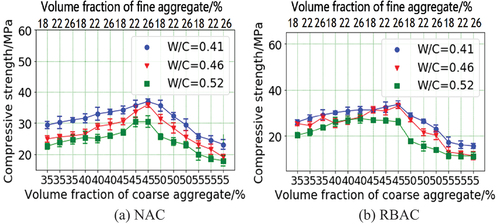
No matter RBA or NA, the compressive strength of concrete reaches the maximum when the volume content of coarse aggregate is about 45% and the volume content of fine aggregate is about 26%. This shows that when the volume content of coarse and fine aggregates is around this range, on the one hand, the thickness of cement mortar is in the optimal range, which can effectively bond the coarse and fine aggregates; on the other hand, the skeleton filling effect of coarse and fine aggregates is good. Cai et al. (Citation2009) established that the void volume fraction of coarse and fine aggregate in compact state was about 28.48% based on Fuller’s gradation curve. Wang (Citation2012) believed that under ideal conditions, the void of spherical particles with equal diameter in compact state was 26%. Ueno and Ogawa (Citation2019) also pointed out that the optimal volume content of coarse and fine aggregates was about 70%. These conclusions are also highly consistent with the results in this paper.
It can also be found from that when the volume content of RBA or NA exceeds about 45%, the compressive strength of concrete gradually decreases with the increase of the volume content of coarse aggregate. When the volume content of NA exceeds about 50%, the compressive strength of NAC begins to decrease obviously; however, when the volume content of RBA exceeds about 45%, the compressive strength of RBAC begins to decrease obviously. Wang et al (Stock, Hannantt, and Williams Citation1979; Wang Citation2012). also found that when the volume content of coarse aggregate was within the range of 40% ~ 50%, the strength of concrete increased with the increase of the volume content of coarse aggregate; when the volume content of coarse aggregate was not within the range of 40% ~ 50%, the strength of concrete decreases rapidly. This is because with the increase of the volume content of coarse aggregate, the thickness of cement mortar becomes thinner, which leads to the reduction of the bond strength between cement mortar and coarse aggregate. Chang et al (Citation2011). indicated that the strength of RAC reached the maximum when the volume content of RA was about 42%. Tasdemir and Karihaloo (Citation2001) also pointed out that when the volume content of coarse aggregate and fine aggregate was 50% and 20%, respectively, the flexural strength of concrete reached the maximum. The test results of this paper are close to the conclusions in literatures (Chang et al. Citation2011; Tasdemir and Karihaloo Citation2001).
3. The calculation method of concrete compressive strength based on properties and volume content of coarse aggregate
3.1. The optimum range of the volume content of coarse aggregate
Concrete can be regarded as a two-phase composite material composed of cement mortar and coarse aggregate as EquationEq (4)(4)
(4) :
where Va is the volume percentage of coarse aggregate, %; Vcs is the volume percentage of cement mortar, %.
According to the theory of composite material mechanics, the strength of composite material depends on the strength and volume percentage of each phase material, so the compressive strength of concrete can be expressed as EquationEq (5)(5)
(5) :
where fcu is the compressive strength of concrete, MPa; fcs is the compressive strength of cement mortar, MPa; fa is the contribution strength of coarse aggregate, MPa.
EquationEq (6)(6)
(6) is obtained by substituting EquationEq (4)
(4)
(4) into EquationEq (5)
(5)
(5) .
EquationEq (7)(7)
(7) is obtained by equivalent transformation of EquationEq (6)
(6)
(6) :
where fa reflects the contribution of the volume content of coarse aggregate to the compressive strength of concrete.
The relationship among contribution strength of RBA, compressive strength of cement mortar and compressive strength of RBAC is shown in . It can be found that contribution strength of RBA and compressive strength of RBAC have a similar growth trend, which first increase and then decrease with the increase of the volume content of RBA. When the volume content of RBA is 35% ~ 50%, the contribution strength of RBA is the largest, followed by the compressive strength of concrete, finally the compressive strength of cement mortar; when the volume content of RBA exceeds 50%, both the contribution strength of RBA and the compressive strength of RBAC are less than the compressive strength of cement mortar, furthermore, the reduction of RBA contribution strength is greater.
Figure 12. The relationship among RBA contribution strength, cement mortar compressive strength and RBAC compressive strength.

The relationship among contribution strength of NA, compressive strength of cement mortar and compressive strength of NAC is shown in . It can be found that the trend of the contribution strength of NA is similar to that of the contribution strength of RBA. The difference is that the contribution strength of NA and the compressive strength of NAC are slightly lower than the compressive strength of cement mortar when the volume content of NA exceeds 55%, in addition, the contribution strength of NA and the compressive strength of NAC are not significantly lower than the compressive strength of cement mortar.
Figure 13. The relationship among NA contribution strength, cement mortar compressive strength and NAC compressive strength.
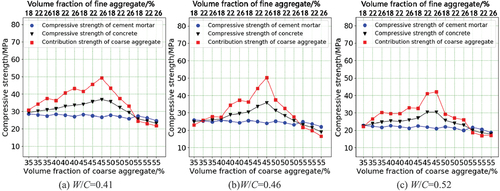
The strengthening effect of coarse aggregate on the compressive strength of concrete can be defined as the contribution strength coefficient and the reinforcement coefficient of coarse aggregate, which are shown in EquationEqs (8)(8)
(8) and (Equation9
(9)
(9) ), respectively:
where Ka’ is the contribution strength coefficient of coarse aggregate; Ka is the reinforcement coefficient of coarse aggregate.
The value of Ka’ reflects the contribution strength of coarse aggregate to concrete skeleton. When Ka’ > 1, it indicates that the contribution strength of coarse aggregate to concrete skeleton is higher than that of concrete, the filling effect of coarse aggregate is fully utilized; when Ka’≤1, it indicates that the contribution strength of coarse aggregate to concrete skeleton is less than that of concrete, the filling effect of coarse aggregate is not fully utilized.
The value of Ka reflects the contribution of coarse aggregate to the strength of cement mortar. When Ka >1, it indicates that the compressive strength of concrete is greater than that of cement mortar, the volume content of coarse aggregate is within optimal range; When Ka ≤1, it indicates that the compressive strength of concrete is less than that of cement mortar, the volume content of coarse aggregate is not within optimal range.
The contribution strength coefficient and reinforcement coefficient of RBA and NA calculated according to EquationEqs (8)(8)
(8) and (Equation9
(9)
(9) ) are shown in . It can be found that the contribution strength coefficient and reinforcement coefficient of coarse aggregate have the same enhanced range. For RBA, when the volume percentage of coarse aggregate is between 35% and 50%, Ka’ and Ka are both greater than 1; for NA, when the volume percentage of coarse aggregate is between 35% and 55%, Ka’ and Ka are both greater than 1. This indicates that NA has a larger range of compressive strength enhancement than RBA.
3.2. The optimum range of volume content of fine aggregate
Fine aggregate is the reinforcing particle of cement mortar. There is an optimal volume range of fine aggregate in cement mortar. Cement mortar can be regarded as a two-phase material composed of fine aggregate and cement paste, which is shown in EquationEq (10)(10)
(10) :
where Vs is the volume percentage of fine aggregate, %; Vc is the volume percentage of cement paste, %.
According to the theory of composite material mechanics, the strength of composite material depends on the strength and volume percentage of each phase material, so the compressive strength of cement mortar can be expressed as EquationEq (11)(11)
(11) :
where fcs is the compressive strength of cement mortar, MPa; fc is the compressive strength of cement paste, MPa; fs is the contribution strength of fine aggregate, MPa.
EquationEq (12)(12)
(12) is obtained by substituting EquationEq (10)
(10)
(10) into EquationEq (11)
(11)
(11) .
EquationEq (13)(13)
(13) is obtained by equivalent transformation of EquationEq (12)
(12)
(12) :
The contribution strength of fine aggregate reflects the contribution of the volume content of fine aggregate to the strength of cement mortar.
The relationship among the contribution strength of fine aggregate, the compressive strength of cement paste and the compressive strength of cement mortar with different water cement ratios and sand cement ratios is shown in . It can be found that the contribution strength of fine aggregate and the compressive strength of cement mortar with different water cement ratios increase first and then decrease with the increase of sand cement ratio. When sand cement ratio is about 0.5, the contribution strength of fine aggregate reaches the maximum value, which indicates that when sand cement ratio is about 0.5, the contribution of fine aggregate to the strength of cement mortar is the largest; when sand cement ratio is about 0.75, the compressive strength of cement mortar reaches the maximum value, which indicates that the best sand cement ratio is about 0.75. At the same time, it can also be found that when sand cement ratio is less than 2, the contribution strength of fine aggregate and the compressive strength of cement mortar are greater than the compressive strength of cement paste, which indicates that the addition of fine aggregate is conducive to improving the compressive strength of cement mortar; when sand cement ratio is greater than 2, the contribution strength of fine aggregate and the compressive strength of cement mortar are both less than the compressive strength of cement paste, which indicates that with the increase of the volume content of fine aggregate, the thickness of cement paste becomes thinner, the bond strength between cement paste and fine aggregate decreases.
The strengthening effect of fine aggregate on the compressive strength of cement mortar can be defined as the contribution strength coefficient and the reinforcement coefficient of fine aggregate, which are shown in EquationEqs (14)(14)
(14) and (Equation15
(15)
(15) ) respectively:
Where, Ks’ is the contribution strength coefficient of fine aggregate; Ks is the reinforcement coefficient of fine aggregate.
The value of Ks’ reflects the contribution strength of fine aggregate to cement mortar skeleton. When Ks’>1, it indicates that the contribution strength of fine aggregate to cement mortar skeleton is higher than that of cement mortar, the filling effect of fine aggregate is fully utilized; when Ks’≤1, it indicates that the contribution strength of fine aggregate to cement mortar skeleton is less than that of cement mortar, the filling effect of fine aggregate is not fully utilized.
The value of Ks reflects the contribution of fine aggregate to the strength of cement mortar. When Ks >1, it indicates that the compressive strength of cement mortar is greater than that of cement paste, the volume content of fine aggregate is within optimal range; When Ks ≤1, it indicates that the compressive strength of cement mortar is less than that of cement paste, the volume content of fine aggregate is not within optimal range.
The contribution strength coefficient and the reinforcement coefficient of fine aggregate under different water cement ratios and sand cement ratios are calculated according to EquationEqs (14)(14)
(14) and (Equation15
(15)
(15) ) as shown in . It can be seen that the contribution strength coefficient and the reinforcement coefficient of fine aggregate have similar trends with sand cement ratio. When sand cement ratio is between 0.3 and 2.5, Ks’ and Ks are both greater than 1; when sand cement ratio is about 0.5, Ks’ reaches the maximum; when sand cement ratio is about 0.75, Ks reaches the maximum. This shows that cement paste can be enhanced by fine aggregate with sand cement ratio between 0.3 and 2.5.
3.3. The calculation method of the compressive strength of concrete
3.3.1. The calculation equation for compressive strength of cement mortar
Concrete can be seen as a two-phase material composed of coarse aggregate and cement mortar as shown in EquationEq (16)(16)
(16) , wherein cement mortar is composed of cement paste and fine aggregate as shown in EquationEq (17)
(17)
(17) . Cement paste is composed of cement and water as shown in EquationEq (18)
(18)
(18) . The strength of cement paste is determined by water cement ratio, the strength of cement mortar is determined by water cement ratio and sand cement ratio.
Where, Vtotal is the volume percentage of cement mortar and coarse aggregate, %; Vcs-w is the volume percentage of cement mortar, %.
Where, Vc-w is the volume percentage of cement paste, %; Vc is the volume percentage of cement, %; Vw is the volume percentage of water, %.
Sand/cement paste ratio is an important parameter that affects the strength of cement mortar (Wang Citation2012).
Where, Ps is sand/cement paste ratio; ms is the mass of sand; mc is the mass of cement; mw is the mass of water.
EquationEq (20)(20)
(20) can be obtained by dividing the numerator and denominator of EquationEq (19)
(19)
(19) by mc:
Where, S/C is sand cement ratio; W/C is water cement ratio.
From EquationEq (20)(20)
(20) , it can be found that sand/cement mortar ratio is determined by sand cement ratio and water cement ratio. The strength of cement mortar increases with the decrease of water cement ratio and then decreases with the increase of sand cement ratio. The compressive strength of cement mortar is regarded as a dependent variable, water cement ratio and sand cement ratio are regarded as independent variables. Then the compressive strength of cement mortar is regarded as a curved surface function of water cement ratio and sand cement ratio. Considering the influence of admixture, the calculation method is shown in EquationEq (21)
(21)
(21) :
Where, Acs, Bcs, Ccs, Dcs, Ecs and Fcs are fitting coefficients.
The test results are fitted by EquationEq (21)(21)
(21) , the fitting results are shown in . It can be found that the compressive strength of cement mortar decreases with the increase of water cement ratio and increases first and then decreases with the increase of sand cement ratio. These laws are consistent with the test results. After calculation, the correlation coefficient between the calculated value of EquationEq (21)
(21)
(21) and the test value reaches 0.97, so EquationEq (21)
(21)
(21) can be used to calculate the compressive strength of cement mortar under different water cement ratios and sand cement ratios.
3.3.2. The calculation equation of the compressive strength of concrete
The compressive strength of concrete mainly depends on the compressive strength of cement mortar, furthermore, the addition of coarse aggregate changes the crack propagation path. NA prolongs the crack propagation path of concrete to improve the energy dissipation capacity of concrete, while RBA partially changes the crack propagation path of concrete (Jiang Citation2010), so the addition of coarse aggregate plays a role in enhancing the compressive strength of concrete. In this state, the compressive strength of concrete mainly depends on the strength of cement mortar, in addition, coarse aggregate plays a reinforcing role.
The equation for calculating the compressive strength of concrete is given in literature (Rajamane and Ambily Citation2012) as shown in EquationEq (22)(22)
(22) .
Where, C/W is cement water ratio; A=αafcs, B=-αaαbfcs; fcs is the 28d compressive strength of cementitious material, MPa; αa and αb are regression coefficients.
It can be seen from EquationEq (22)(22)
(22) that the compressive strength of concrete is positively related to fcs and C/W. If the cement strength grade is determined, the compressive strength of concrete is only linearly related to C/W. According to the test results in this paper, the reinforcement effect of coarse aggregate increases first and then decreases with the volume fraction of coarse aggregate. Therefore, considering the reinforcement effect of coarse aggregate, EquationEq (22)
(22)
(22) can be rewritten into EquationEq (23)
(23)
(23) :
Where, Ac, Bc and Cc are regression coefficients; fa(Vx) is the influence function of the volume fraction of coarse aggregate; Vx is the volume fraction of coarse aggregate, %.
The variable parameter results of fa(Vx) are shown in . It can be found that fa(Vx) is mainly affected by Ac. The larger Ac, the larger fa(Vx). The curve shape of fa(Vx) is mainly affected by Bc. When the value of Bc is less than 1.5, the curve increases with the increase of x; when the value of Bc is greater than 1.5, the curve increases first and then decreases; when the value of Bc is greater than 5, the curve approximates a straight line. After fitting, the Bc of RBAC and NAC are 1.7458 and 1.9058, respectively. The curvature of fa(Vx) is mainly affected by Cc. The larger Cc, the greater the curvature of fa(Vx).
3.3.3. Experimental verification of the calculation equation of concrete compressive strength
For NAC and RBAC, the parameters of fa(Vx) are fitted, the fitting results are shown in :
Table 4. Parameter value.
The data in references (Beshr, Almusallam, and Maslehuddin Citation2003; Chen et al. Citation2019; Guo et al. Citation2018; Han, Zhang, and Wang Citation2013; Kong Citation2003; Younis and Pilakoutas Citation2013; Zhang et al. Citation2012) was predicted by EquationEq (23)(23)
(23) , the predicted results are shown in . For NAC, the correlation coefficient between the predicted values and the test values is 0.92; for RBAC, the correlation coefficient between the predicted values and the test values is 0.93. It can be seen that the predicted values are highly correlated with the test values, so EquationEq (23)
(23)
(23) can be used to calculate the compressive strength of concrete with different volume contents of coarse aggregate.
4. Conclusion
The effective water absorption, apparent density and crushing index of different types of coarse aggregate were tested. The contribution strength coefficient and reinforcement coefficient of coarse and fine aggregate were proposed according to the mechanics of composite materials, the optimal range of the volume content of coarse and fine aggregate was determined, the calculation equation of compressive strength based on the properties of coarse aggregate and the volume content of coarse and fine aggregate was established. The important conclusions are as follows:
The effective water absorption of RBA is 8.18% and that of NA is 0.32%; the apparent density of NA is 2713 kg/m3 and that of RBA is 2100 kg/m3; the crushing index of NA is 18.07% and that of RBA is 30.59%, furthermore, the crushing value of RBA is close to that of cement mortar with water cement ratio of 0.46.
For RBA, when the volume percentage of coarse aggregate is between 35% and 50%, Ka’ and Ka are greater than 1; for NA, when the volume percentage of coarse aggregate is between 35% and 55%, Ka’ and Ka are both greater than 1; when sand cement ratio is between 0.3 and 2.5, both Ks’ and Ks are greater than 1; when sand cement ratio is about 0.5, Ks’ reaches the maximum value; when sand cement ratio is about 0.75, Ks reaches the maximum value. So when the volume fraction of coarse aggregate is between 35% −50%, and sand cement ratio is between 0.5-0.75, concrete has greater compressive strength, which also provides good experience for engineering applications.
A equation for predicting the compressive strength of concrete has been proposed, in which the types of coarse aggregate, the volume content of coarse aggregate, sand cement ratio and water cement ratio are considered. A large amount of data indicates that the established equation has high prediction accuracy.
Acknowledgements
Jiangsu Province Higher Education Basic Science (Natural Science) Research Major Project in 2023 (23KJA560003), Henan science and technology research plan project in 2021 (212102310394) and Lanzhou University Open Fund in 2021 (202112).
Disclosure statement
The authors declare that they have no known competing financial interests or personal relationships that could have appeared to influence the work reported in this paper.
Additional information
Notes on contributors
Xiaohong Chen
Xiaohong Chen, female, lecturer of Railway Engineering College, Zhengzhou Railway Vocational & Technical College, majoring in recycled concrete.
Yueyue Zhang
Yueyue Zhang, female, lecturer of Railway Engineering College, Zhengzhou Railway Vocational & Technical College, majoring in recycled concrete.
Pei Ge
Pei Ge, male, lecturer of School of Civil Engineering and Architecture, Changzhou Institute of Technology, majoring in recycled concrete.
References
- Basaran, B., I. Kalkan, C. Aksoylu, Y. O. Özkılıç, and M. M. S. Sabri. 2022. “Effects of Waste Powder, Fine and Coarse Marble Aggregates on Concrete Compressive Strength [J.” Sustainability 14 (21): 14388. https://doi.org/10.3390/su142114388.
- Beshr, H., A. A. Almusallam, and M. Maslehuddin. 2003. “Effect of Coarse Aggregate Quality on the Mechanical Properties of High Strength Concrete.” Construction and Building Materials 17 (2): 97–103. https://doi.org/10.1016/S0950-0618(02)00097-1.
- Cai, Z. D., J. Z. Zhang, S. T. Ye, L. S. Li, and Z. L. Huang. 2009. “New Approach to Design Concrete Mix Proportions by Coating Thickness of Aggregates.” Journal of Building Materals 2:30–35. https://doi.org/10.3969/j.issn.1007-9629.2009.02.006.
- Çelik, A. I., Y. O. Özkılıç, Ö. Zeybek, M. Karalar, S. Qaidi, J. Ahmad, D. D. Burduhos-Nergis, and C. Bejinariu. 2022. “Mechanical Behavior of Crushed Waste Glass as Replacement of Aggregates [J].” Materials 15 (22): 8093. https://doi.org/10.3390/ma15228093.
- Chang, C. Y., R. Huang, P. C. Lee, and T. L. Weng. 2011. “Application of a Weighted Grey-Taguchi Method for Optimizing Recycled Aggregate Concrete Mixtures.” Cement and Concrete Composites 33 (10): 1038–1049. https://doi.org/10.1016/j.cemconcomp.2011.06.005.
- Chen, Y. W., Z. M. Li, and K. W. Wu. 2018. “Influence of Binder-Sand Ratio on Fiber-Reinforced Cementitious Composites Performance.” Concrete 3:68–70+74. https://doi.org/10.3969/j.issn.1002-3550.2018.03.016.
- Chen, F., K. Wu, L. Ren, J. Xu, and H. Zheng. 2019. “Internal Curing Effect and Compressive Strength Calculation of Recycled Clay Brick Aggregate Concrete.” Materials 12 (11): 1815. https://doi.org/10.3390/ma12111815.
- Dan, M., A. Xw, A. Hq, and C. Zhu. 2021. “A Strength-Based Mix Design Method for Recycled Aggregate Concrete and Consequent Durability Performance.” Construction and Building Materials 281:122616. https://doi.org/10.1016/j.conbuildmat.2021.122616.
- Guo, Y. X., Q. Y. Li, G. B. Yue, and Q. Q. Li. 2018. “Calculation of Compressive Strength of Recycled Concrete Based on Coarse Aggregate Quality and Replacement Rate.” Journal of Building Structures 39 (4): 153–159. https://doi.org/10.14006/j.jzjgxb.2018.04.017.
- Han, Y. D., J. Zhang, and Y. Gao. 2013. “Effect of Coarse Aggregate Content on Fracture Parameters of Concrete.” Engineering Mechanics 30 (3): 191–197. https://doi.org/10.6052/j.issn.1000-4750.2011.09.0641.
- Han, Y. D., J. Zhang, and Z. B. Wang. 2013. “Effect of Volume Fraction of Coarse Aggregate on Elastic Modulus and Compressive Strength of Concrete.” Journal of Harbin Institute of Technology 45 (4): 84–91. https://doi.org/10.11918/j.issn.0367-6234.2013.04.016.
- Jiang, C. S. 2010. Research on Brittleness Mechanism and Modification of High Strength Lightweight Concrete [D]. Hubei, China: Wuhan University of Technology. https://doi.org/10.7666/d.y1821500.
- Kargari, A., H. Eskandari-Naddaf, and R. Kazemi. 2018. “Effect of Cement Strength Class on the Generalization of Abrams’ Law.” Structural Concrete 20 (1): 493–505. https://doi.org/10.1002/suco.201700275.
- Kong, D. Y. 2003. “Unified Bolomey’s Formula of Concrete Made with Natural and Recycled Coarse aggregate(I)—Effect of Strength of Coarse Aggregate.” Journal of Building Materials 6 (2): 129–134. https://doi.org/10.3969/j.issn.1007-9629.2003.02.004.
- Li, K. 2005. Recycled Aggregate and Recycled Aggregate Concrete Performance [D]. Dalian, China: Dalian University of Technology. https://doi.org/10.7666/d.y825290.
- Moini, M., I. Flores-Vivian, A. Amirjanov, and K. Sobolev. 2015. “The Optimization of Aggregate Blends for Sustainable Low Cement Concrete.” Construction and Building Materials 93 (15): 627–634. https://doi.org/10.1016/j.conbuildmat.2015.06.019.
- Myong Lee, K., O. Buyukozturk, and A. Oumera. 1992. “Fracture Analysis of Mortar-Aggregate Interfaces in Concrete.” Journal of Engineering Mechanics 118 (10): 2031–2046. https://doi.org/10.1061/(ASCE)0733-9399(1992)118:10(2031).
- Nikbin, I. M., M. Beygi, M. T. Kazemi, J. Vaseghi Amiri, E. Rahmani, S. Rabbanifar, and M. Eslami. 2014a. “A Comprehensive Investigation into the Effect of Aging and Coarse Aggregate Size and Volume on Mechanical Properties of Self-Compacting Concrete.” Materials and Design 59:199–210. https://doi.org/10.1016/j.matdes.2014.02.054.
- Nikbin, I. M., M. Beygi, M. T. Kazemi, J. Vaseghi Amiri, E. Rahmani, S. Rabbanifar, and M. Eslami. 2014b. “Effect of Coarse Aggregate Volume on Fracture Behavior of Self Compacting Concrete.” Construction and Building Materials 52:137–145. https://doi.org/10.1016/j.conbuildmat.2013.11.041.
- Noaman, A. T., G. S. Jameel, and S. Kamil. 2021. “Producing of Workable Structural Lightweight Concrete by Partial Replacement of Aggregate with Yellow And/Or Red Crushed Clay Brick (CCB) Aggregate.” Journal of King Saud University 33 (4): 240–247. https://doi.org/10.1016/j.jksues.2020.04.013.
- Özturan, T., and C. Çeçen. 1997. “Effect of Coarse Aggregate Type on Mechanical Properties of Concretes with Different Strengths.” Cement and Concrete Research 27 (2): 165–170. https://doi.org/10.1016/S0008-8846(97)00006-9.
- Qaidi, S., H. M. Najm, S. M. Abed, Y. O. Özkılıç, H. Al Dughaishi, M. Alosta, M. M. S. Sabri, F. Alkhatib, and A. Milad. 2022. “Concrete Containing Waste Glass as an Environmentally Friendly Aggregate: A Review on Fresh and Mechanical Characteristics [J.” Materials 15 (18): 6222. https://doi.org/10.3390/ma15186222.
- Rajamane, N. P., and P. S. Ambily. 2012. “Modified Bolomey Equation for Strengths of Lightweight Concretes Containing Fly Ash Aggregates.” Magazine of Concrete Research 64 (4): 1667–1680. https://doi.org/10.1680/macr.11.00157.
- Sadrmomtazi, A., O. Lotfi-Omran, and I. M. Nikbin. 2020. “Influence of Cement Content and Maximum Aggregate Size on the Fracture Parameters of Magnetite Concrete Using WFM, SEM and BEM.” Theoretical and Applied Fracture Mechanics 107 (1): 1–17. https://doi.org/10.1016/j.tafmec.2020.102482.
- She, A. M. 2007. Study on Moisture Content and Microstructure of Concrete in Dry Climate with Large Temperature Difference [D]. Hubei, China: Wuhan University of Technology. https://doi.org/10.7666/d.y1119531.
- Stock, A. F., D. J. Hannantt, and R. I. T. Williams. 1979. “The Effect of Aggregate Concentration Upon the Strength and Modulus of Elasticity of Concrete.” Magazine of Concrete Research 31 (109): 225–234. https://doi.org/10.1680/macr.1979.31.109.225.
- Struble, L., J. Skalny, and S. Mindess. 1980. “A Review of the Cement-Aggregate Bond.” Cement and Concrete Research 10 (2): 277–286. https://doi.org/10.1016/0008-8846(80)90084-8.
- Tasdemir, M. A., and B. L. Karihaloo. 2001. “Effect of Aggregate Volume Fraction on the Fracture Parameters of Concrete: A Meso-Mechanical Approach.” Magazine of Concrete Research 53 (6): 405–415. https://doi.org/10.1680/macr.2001.53.6.405.
- Trende, U., and O. Büyükztürk. 1998. “Size Effect and Influence of Aggregate Roughness in Interface Fracture of Concrete Composites.” ACI Materials Journal 95 (4): 331–338. https://doi.org/10.1007/BF02480473.
- Ueno, A., and Y. Ogawa. 2019. “Influence of Coarse Aggregate Shape on Optimum Fine to Total Aggregate Ratio Using a Virtual Voids-Ratio Diagram in Concrete Compaction.” Cement and Concrete Composites 106:103463. https://doi.org/10.1016/j.cemconcomp.2019.103463.
- Wang, Z. S. 2012. Study on Basic Theory of Frame Concrete [D]. Dalian, China: Dalian University of Technology.
- Ying, J. W., and H. G. Chen. 2011. “Influence of Recycled Aggregates Volume Fraction on Chloride Diffusion in Model Recycled Aggregates Concrete.” Advanced Materials Research 261-263:151–155. https://doi.org/10.4028/www.scientific.net/AMR.261-263.151.
- Younis, K. H., and K. Pilakoutas. 2013. “Strength Prediction Model and Methods for Improving Recycled Aggregate Concrete.” Construction and Building Materials 49:688–701. https://doi.org/10.1016/j.conbuildmat.2013.09.003.
- Zeybek, Ö., Y. O. Özkılıç, M. Karalar, A. İ. Çelik, S. Qaidi, J. Ahmad, D. D. Burduhos-Nergis, and D. P. Burduhos-Nergis. 2022. “Influence of Replacing Cement with Waste Glass on Mechanical Properties of Concrete [J.” Materials 15 (21): 7513. https://doi.org/10.3390/ma15217513.
- Zhang, Y. J., S. He, X. Zhang, Liu, X., Lu, W. Q., et al. 2012. “Modification of the Bolomey Formula in Recycled Aggregate Concrete.” Journal of Building Materials 15 (4): 538–543. https://doi.org/10.3969/j.issn.1007-9629.2012.04.020.
- Zhang, L. X., W. M. Lu, B. Chen, Wu, K. R., et al. 2001. “Effects of aggregates’ Character on Concrete Fracture Performance and Acoustic Emission.” Journal of Tongji University (Natural Science) 29 (5): 546–550. https://doi.org/10.3321/j.issn:0253-374X.2001.05.009.
- Zhang, J. X., B. Wang, and B. Song. 2018. “Composition Design and Performance Characterization of a Novel Backfilling Concrete Derived from Urban Construction Waste.” Journal of Cleaner Production 190:508–516. https://doi.org/10.1016/j.jclepro.2018.04.181.
- Ziembicka, H. 1977. “Effect of Micropore Structure on Cellular Concrete Shrinkage.” Cement and Concrete Research 7 (3): 323–332. https://doi.org/10.1016/0008-8846(77)90095-3.

